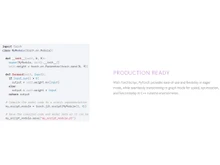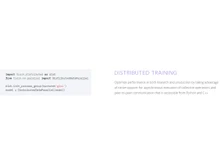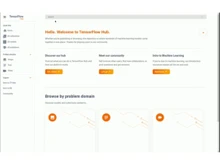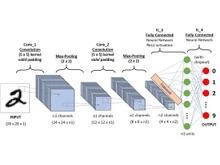PyTorch and TensorFlow are two prominent frameworks in the field of deep learning, each solution serving as a comprehensive foundation for building and deploying machine learning models.
While both platforms serve a similar purpose, there are some differences between PyTorch and TensorFlow. We have differentiated PyTorch vs TensorFlow based on their pros and cons, visualization library, debugging, and more.
PyTorch vs. TensorFlow: An Overview
PyTorch is a robust machine learning framework based on the basic principles of Python programming language, including the Torch library. It is written in Lua scripting language and is one of the preferred platforms for deep learning research. The software offers several features: cloud support, a robust ecosystem, and distributed training.
On the other hand, TensorFlow was developed by Google and released to the public in 2015; it is an open-source library used for numerical computation and large-scale machine learning. Some key features that TensorFlow offers are pre-built algorithms, application integration, and more.
Between PyTorch and TensorFlow, PyTorch is often preferred for its ease of use in prototyping, while TensorFlow's extensive deployment options make it a favorable choice for production pipelines.
PyTorch vs TensorFlow: Pros & Cons
- PyTorch has limited resources in terms of libraries and tools compared to TensorFlow, which has a comprehensive library of pre-built tools and models for a better user experience.
- Debugging in PyTorch is simple because of its Pythonic syntax and dynamic computation graph, while debugging in TensorFlow can be complex due to the static computation graph.
- PyTorch does not support native Keras integration, but TensorFlow supports native Keras integration, further simplifying the model-building and training process.
- TensorFlow comes with an extensive visualization tools used for building model graphs. On the contrary, PyTorch does not offer support for any such functionality.
PyTorch vs TensorFlow: In Terms of Features
- Distributed Training: One of the main features that differentiates PyTorch from TensorFlow is how they handle data parallelism. PyTorch thoroughly optimizes the performance by using Python's built-in support. On the other hand, in TensorFlow, you are supposed to manually code and fine-tune every operation to run it across different devices for distributed training.
- Visualization: Based on visualization features in the training process, TensorFlow takes the lead. Visualization is an essential feature that helps developers track the training process and debug it in a more hassle-free way. TensorFlow's visualization library is known as TensorBoard, while PyTorch developers use Visdom. The features offered by Visdom are very basic and limited, which makes TensorBoard a winner under this parameter.
- Production Deployment: You can easily deploy models in TensorFlow by using TensorFlow serving. Unlike TensorFlow, PyTorch does not offer any framework to deploy the models directly to the web. In PyTorch, you're supposed to use Flask or Django as the backend server. Therefore, TensorFlow will be a better option if you are more concerned about performance.
- Graph Definition: TensorFlow operates on a static graph concept, so it is important for the user to first define the computation graph and then run the machine learning model. In simple terms, TensorFlow has its graphs pre-constructed at the beginning of a training. On the contrary, PyTorch has a competitive edge due to its dynamic computational graph construction, which means that the graphs are constructed when the operations are executed.
PyTorch vs TensorFlow: Ease of Use
Both PyTorch and TensorFlow have improved their user interfaces, but PyTorch is considered more user-friendly with a dynamic computational graph, which makes it easy for beginners to understand and debug. TensorFlow has a static computational graph that makes machine learning complex for beginners.
PyTorch vs. TensorFlow: API Design
PyTorch has a Pythonic design that makes it highly approachable for beginners and researchers, as its API is intuitive, and it allows for easy experimentation and customization. On the other hand, TensorFlow has a strong abstraction process that serves as a solid foundation for building complex models. In addition, it has a steep learning curve, which makes it unfavorable among beginners.
PyTorch vs TensorFlow: Community and Ecosystem
PyTorch and TensorFlow boast a vibrant community of comprehensive online resources, tutorials, and libraries. At the same time, TensorFlow's community and corporate support from Google has resulted in a broad range of pre-trained models and tools. However, PyTorch has gained massive popularity among researchers and academics for its flexibility.
PyTorch vs. TensorFlow: GPU Support
With PyTorch, multi-GPU support is easier to set up and use. However, TensorFlow's multi-GPU support is more complex and requires a more extensive setup.
PyTorch vs. TensorFlow: Keras Integration
PyTorch does not offer support for native Keras integration, whereas TensorFlow has a native Keras integration that simplifies the model training and building process.
Which is Better, PyTorch or TensorFlow?
PyTorch surpasses TensorFlow in several key areas, thereby making it a better choice for many users. Firstly, debugging in PyTorch is simple, because of its dynamic computation graph. In addition, PyTorch is more user-friendly, making it easy for beginners to understand and debug.
However, TensorFlow shines in visualization functionality. It has an extensive visualization library known as TensorBoard that makes it easy for the users to understand the training process and thoroughly improve the model performance.


 6 Ratings & 0 Reviews
6 Ratings & 0 Reviews


















